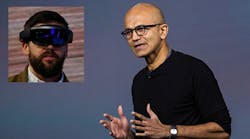Microsoft inventor Alex Kipman was joined by holograms at a renowned TED gathering Thursday as he gave a glimpse into a future where computer screens are relics.
Kipman slipped on HoloLens augmented reality (AR) headgear that his team is readying for market and became a wizard of sorts, calling forth magical landscapes, cold-hard data, and even summoning the hologram of a NASA scientist for a chat.
Kipman spoke of HoloLens and other augmented-reality devices as a step in an evolution to a time when pecking at smartphone screens or computer keyboards are tales from generations past.
“I am talking about freeing ourselves from the two-dimensional confines of traditional computing,” said Kipman, the creator behind Kinect motion-tracking accessories for Xbox video game consoles. “We are like cave people in computer terms. We barely discovered charcoal and started drawing the first stick figures in our cave.”
Walking on the Moon
He touted the HoloLens headset he wore as the first fully-untethered holographic computer; not relying on a connection to a smartphone or computer.
A camera showed the TED audience what Kipman saw through HoloLens as he used gestures to turn the space around him into a cave, a fantasy land and even the surface of the Moon.
He made a virtual television screen appear in the air, demonstrating how augmented reality gear could eliminate the need for real TV sets.
“Computers give us superpowers,” Kipman said as he transformed the world around him with holograms. “In digital space, we have the power to displace space and time.”
With another gesture, he launched a video phone call to his family.
“I believe our children’s children will grow up in a world devoid of two-dimensional technology,” Kipman said. “I can see holographical telepresence in our future.”
To prove his point, Kipman had Jeff Norris of NASA’s Jet Propulsion Laboratory appear on stage in the form of a hologram seen through HoloLens.
HoloLens is already being used on the International Space Station and by NASA scientists, according to Norris.
“For decades, we have explored from a seat, behind screens and keyboards,” Norris said. “Now, we are leaping over all of that, ... the antennae, the satellites and the vast space between worlds to step on the landscape as though we were really there.”
Microsoft has made HoloLens kits available to developers for $3,000 a piece, but has remained mum regarding when versions of the AR visors will be sold to consumers or at what price. The plan is to have a rich array of applications, games and other AR experiences available before HoloLens hits the market, Kipman told AFP.
“You only get one chance to make a first impression,” he said.
When Microsoft unveiled the HoloLens slightly more than a year ago, CEO Satya Nadella billed it as a “mind-blowing” experience that will open a new type of computing.
A Budding ‘Revolution’
Silicon Valley-based AR startup Meta let people at TED experience AR for themselves, with demonstrations that proved so popular the schedule was packed throughout the five-day gathering.
“I think Iron Man would be proud,” Meta CEO Meron Gribetz said while showing off the technology at TED this week. “Being hunched over phones or computers is the wrong way. In the next few years, humanity is going to go through a shift. We are going to start putting a layer of information over the world.”
He predicted that within about five years, AR headgear would be slimmed down to mere strips of glass over people’s eyes.
Meta did not disclose pricing or availability of its AR headsets, which plug into computers, but a countdown clock at the startup’s website on Thursday indicated that “the revolution begins” in less than two weeks.
By Glenn Chapman
Copyright Agence France-Presse, 2016



